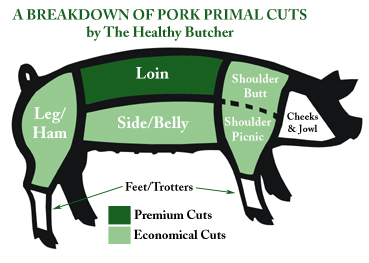
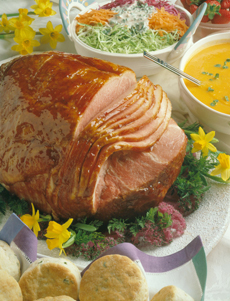 Baked ham with apricot glaze. Photo courtesy National Pork Board. Baked ham with apricot glaze. Photo courtesy National Pork Board.
April 2010
Last Updated April 2015
|
 |
Pork Cuts, Pork Products Glossary & Cuts Of Pork Chart
Page 5: Ham & Other Definitions With H & I
This is Page 5 of a nine-page glossary, including a cuts of pork chart and terms such as ham, heritage pork and Irish bacon. Click on the black links below to visit other pages. See our many other food glossaries.
This glossary is protected by copyright and cannot be copied in whole or in part.
You are welcome to link it.
Chart courtesy TheHealthyButcher.com. For a more detailed chart, see Page 1.
|
HAM
The ham comes from the back legs of the pig: It comprises the thigh and rear end of the pig. The bone is often left in, which adds flavor and includes the rump (the upper portion), the center and the shank (the lower portion). The upper part of the leg (above the knee) is called shank end; the bottom of the leg produces trotters. Ham can be cured or fresh. Different countries use different methods of curing and cooking the ham. See our separate glossary on the different types of ham.
|
|
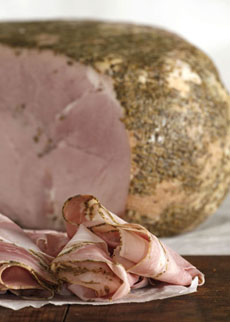
A rosemary-crusted ham from DeLallo.com. |
HAM HOCK
The ham hock is the joint between the tibia/fibula and the part of foot where it is attached to the pig’s leg. This cut generally has too much skin and gristle to be eaten directly. Instead, it is often cooked with greens and other vegetables, or in soups, to provide a smoky pork flavor. Try it in this delicious recipe for barbecue pork butt (pulled pork).
HARD SALAMI or GERMAN HARD
SALAMI
German-style hard salami is a fine-textured blend of pork and beef, accented with garlic and smoky flavor. It is firmer in body than Genoa salami. Hard salami is a popular snack, sandwich ingredient and omelet ingredient. Pair its smoky flavor with some slices of smoked turkey breast or ham, and a spicy brown mustard.
|
|
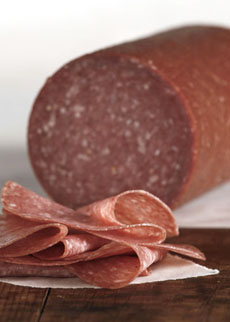
Hard salami from DeLallo.com. |
|
HERITAGE PORK & HERITAGE PIGS
Heritage pigs were what we ate before World War II and the rise of factory farming. They lived primarily outdoor lives, feasting on a natural diet of grass, grubs and grains, plus whey, and produced a fatter, meatier, more tender and tastier pork. With the onset of factory farming (see The Meatrix), pigs were bred to be learner and blander meat (and drier when cooked—because of the higher fat content, it’s hard to overcook heritage pork). Heritage pork is the result of small family farmers trying to keep these “heritage” pigs from extinction. Support from fine restaurants and the growing artisan food movement have helped bring great pork back to American plates. There are a variety of heritage pigs raised in the U.S. The most prevalent include:
|
|
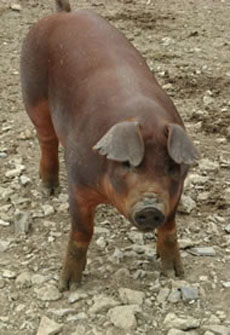
A heritage Duroc pig from GoodFarm.com. |
|
Berkshire, or Kurobuta, Pig. The Berkshire pig is the most popular heritage breed (also known by its Japanese name, Kurobuta). It's beloved for its sweet, meaty, well-marbled flesh. See Berkshire pig.
Duroc Pig. This large red hog was first bred in New York and New Jersey in 1812. The meat is supple, very juicy and full-flavored. See Duroc pig.
Ossabaw Pig. A feral breed of Ibérico pig descent comes from pigs left on Ossabaw Island, Georgia by Spanish explorers. The meat has a wild, almost gamy flavor; but its most distinctive characteristic is a high percentage of healthy, monounsaturated fat. See Ossabaw Island pig.
|
|
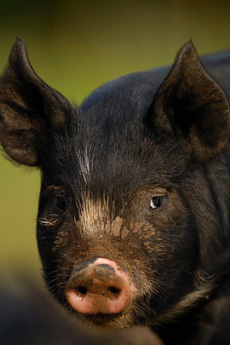
A handsome Berkshire (Kurobuta) pig. Photo by Martin Pateman | Fotolia. |
|
Tamworth Pig. This old-fashioned bacon hog originated in Staffordshire, England—it is said that the meat smells almost like prosciutto. The pig’s ample belly provides excellent bacon; the meat is also used to make the best cured sausages. See Tamworth pig.
Red Wattle Pig. This pig is named for the pair of wattles dangling from its neck. Originally from New Caledonia in the South Pacific, the intensely-flavored pork has a good fat-to-meat ratio, excellent for making salume and air-cured meats. See Red Wattle Pig.
You can purchase heritage pork at HeritageFoodsUSA.com. See also industrial livestock pigs.
|
|
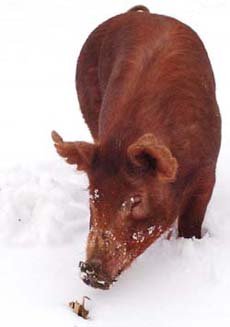
A Tamworth pig rooting in the snow. Photo courtesy Flying Pigs Farm. |
|
THE HISTORY OF PORK
According to the National Pork Board, the pig dates back some 40 million years. Fossils indicate that wild pig-like animals roamed forests and swamps in Europe and Asia. By 4900 B.C.E., pigs were domesticated in China, and were being raised in Europe by 1500 B.C.E. On the insistence of Queen Isabella, Christopher Columbus took eight pigs on his voyage to Cuba in 1493. But it is Hernando de Soto who could be dubbed “the father of the American pork industry.” In 1539 he landed the first 13 pigs at Tampa Bay, Florida. Native Americans reportedly became very fond of the taste of pork, resulting in some of the worst attacks on the de Soto expedition. By the time of de Soto’s death three years later, his pig herd had grown to 700 head, not including the ones his troops had consumed, those that ran away and became wild pigs (the ancestors of today’s feral pigs or razorbacks) and those given to the Native Americans to keep the peace.
|
|
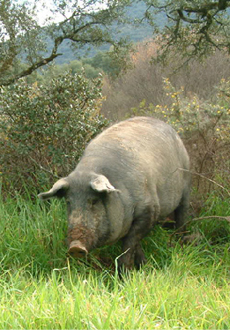
An Iberian pig, perhaps the variety brought to America by Hernando de Soto. Photo courtesy Cinco Jotas. |
|
Pig production spread throughout the New World. Hernando Cortez introduced hogs to New Mexico in 1600, and Sir Walter Raleigh brought sows to Jamestown Colony in 1607. Semi-wild pigs conducted such rampages in the grain fields of colonial New York that every owned pig 14 inches high or taller had to have a ring in its nose to prevent the pig from rooting. A long, solid wall was constructed on the northern edge of the Manhattan settlement to control roaming herds of pigs.—the area that is Wall Street. By 1660, the pig population of Pennsylvania colony numbered in the thousands. By the end of the 17th century, the typical farmer owned four or five pigs, supplying salt pork and bacon for his table with surpluses sold as barreled pork.
|
|
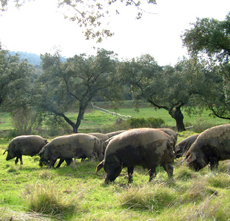
A small herd of Iberian pigs in Spain. Photo courtesy Cinco Jotas. |
What the New World offered pig farmers was a native crop, corn. Finishing pigs (fattening them up prior to harvest) on corn became common practice in Pennsylvania, and then popular in the rest of the country. After the Revolutionary War, pioneers began heading west. A wooden crate filled with young pigs was often hung from the axles of covered wagons. As western herds grew, the need for pork processing facilities became apparent. Packing plants began to spring up in major cities. Pigs were first commercially slaughtered in Cincinnati, which became known as Porkopolis, but just a short while later, during the Civil War, Chicago became the center of cattle and hog processing. Today, here are the nation’s 20 largest pork producers.
|
HOT DOG
The hot dog is a sausage that traces its lineage to the 15th-century Viennese sausage, or Wienerwurst in German. Johann Georghehner, a butcher from the German city of Coburg, in Bavaria, is credited with inventing the “dachshund” or “little dog” sausage in the 17th century, and brought it to Frankfurt—hence the names “frankfurter” and “weiner.” Yet, it was still a sausage eaten with a knife and fork, no bun. The hot dog, a slender sausage in a bun, is an American invention attributed to a German immigrant named Charles Feltman, who began selling sausages in rolls at a stand in Coney Island in 1871. The 1893 World Exposition in Chicago marked the debut of the hot dog vendor. According to National Hot Dog and Sausage Council, around this time that the hot dog first made its first appearance at a ballpark, at a St. Louis Browns.
|
|

A frank dressed with Rick’s Picks pickles. Photo courtesy RicksPicksNYC.com. |
The first published mention of the term “hot dog” as a food first appeared in print in a September 1893 issue of The Knoxville Journal. However, it was well established prior to then. See more of the history of the hot dog.
HOT LINKS
See Andouille sausage.
HOT SMOKING
See smoking.
|
IBÉRICO PIG
The Ibérico (Iberian) pig dates to the time of the cavemen who painted on the walls of the caves of Spain. The strain is distinctly different from other European pigs. Ibérico pigs are all black, with very little hair. The large hog has slender legs and a very long snout. The black hooves have earned the ham the nickname, “pata negra” (black hoof): The black hoof remains on the ham throughout the curing process and is how it can be distinguished from a Serrano ham, made from the Iberian white pig. Ibérico pigs also have a higher fat content. The large amount of fat layering each ham, enables the hams to be cured for a much longer period, resulting in a much more complex, intense flavor.
|
|
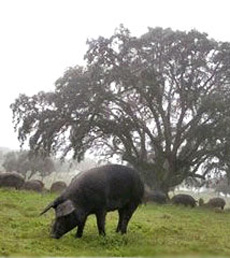
An Ibérico pig and other herd members foraging for acorns. Photo courtesy LaTienda.com. |
The genetics, its diet of acorns and the daily exercise it gets foraging in the forests for the acorns combine to create a unique flavor that is highly valued. In addition, this is “healthy ham”: the fat is monounsaturated with high levels of oleic acid (the same acid found in heart-healthy olive oil). See jamón ibérico.
|
INDUSTRIAL LIVESTOCK PIGS
In contrast to smaller farms rearing heritage pigs, industrial pigs are raised on a much larger scale on industrial farms. They are raised mostly indoors on a commercial feed, and have a considerably shorter life span.
IRISH BACON
Irish bacon is similar to Canadian bacon in that it is made from the loin. However, unlike Canadian bacon, there tends to be a layer of fat around the meat to enhance the flavor. Because it is cut from the loin, it is also called back bacon.
|
|
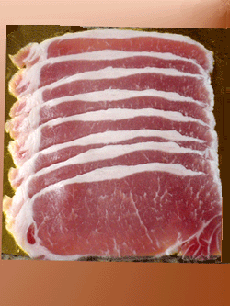
Irish bacon. Photo courtesy IrishGrub.com. |
Continue To Next Page: Pork Definitions J To O
Go To The Article Index Above
Lifestyle Direct, Inc. All rights reserved. Photos are the copyright of their respective owners.

|
|
|





